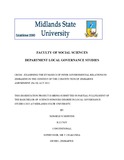Please use this identifier to cite or link to this item:
https://cris.library.msu.ac.zw//handle/11408/2350Full metadata record
| DC Field | Value | Language |
|---|---|---|
| dc.contributor.author | Ndiweni, Nonsele N. | - |
| dc.date.accessioned | 2017-06-29T14:33:40Z | - |
| dc.date.available | 2017-06-29T14:33:40Z | - |
| dc.date.issued | 2015 | - |
| dc.identifier.uri | http://hdl.handle.net/11408/2350 | - |
| dc.description.abstract | The new constitution which was adopted in 2013 saw the constitutionalisation of Local government and Provincial government in Zimbabwe creating a three tier government. Consequently they are three spheres of government, which are national, provincial and local levels. These tiers of government are obliged to work together and mutually cooperate and support each other through peaceful coordination and interactions termed intergovernmental relations (IGR). The basis for IGR in Zimbabwe lies with Sect 5 of the constitution which sets a three tier government and Sect 265 which provides for the creation of an Act of Parliament which will cater for mechanisms and procedures which will facilitate coordination between the tiers of government. Formal structures like the Provincial council and Metropolitan councils have been created by the new constitution to enable IGR thus Chapter 14 Part 2. Sustained inter-governmental relations leads to a coordinated and integrated system of government which can improve public sector governance and service delivery. This research study was to cross examine the dynamics of Intergovernmental relations in Zimbabwe in the context of the Constitution of Zimbabwe Amendment (No 20) Act 2013. The study adopted a qualitative research method in which information was extracted through interviews and secondary data collection techniques. Research population included Inter governmental relation experts who included lecturers in the field, activists and individuals involved in developing the practice of IGR in different spheres of government. Furthermore, Provincial officers and Municipal officers were also part of the research population to gather relevant information to the study. To choose the sample size, purposive sampling was adopted due to the confinement of the study to a certain audience. The study identified dynamics which included political influence, structural deficiencies and poor legislation guiding IGR in Zimbabwe. The effectiveness of IGR is affected and driven by the aforementioned dynamics and conclusions were drawn that the alignment of local government legislation should be completed quickly and help create a conducive environment for IGRs. Furthermore political and administration dichotomy, improved IGR communication and granting of local authorities management autonomy would help improve IGR in the country. | en_US |
| dc.language.iso | en | en_US |
| dc.publisher | Midlands State University | en_US |
| dc.subject | International relations | en_US |
| dc.subject | Inter-governmental relations | en_US |
| dc.subject | Constitutionalism | en_US |
| dc.title | Cross –examining the dynamics of inter-governmental relations in Zimbabwe in the context of the constitution of Zimbabwe Amendment (No 20) Act 2013. | en_US |
| item.fulltext | With Fulltext | - |
| item.languageiso639-1 | en | - |
| item.grantfulltext | open | - |
| Appears in Collections: | Bsc Local Governance Studies Honours Degree | |
Files in This Item:
| File | Description | Size | Format | |
|---|---|---|---|---|
| Ndiweni.pdf | Full text | 2.15 MB | Adobe PDF |  View/Open |
Page view(s)
22
checked on Jul 25, 2024
Download(s)
22
checked on Jul 25, 2024
Google ScholarTM
Check
Items in MSUIR are protected by copyright, with all rights reserved, unless otherwise indicated.



